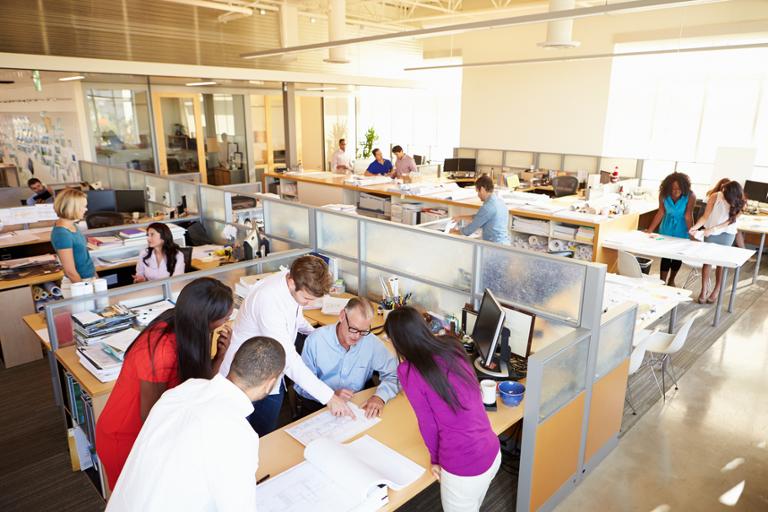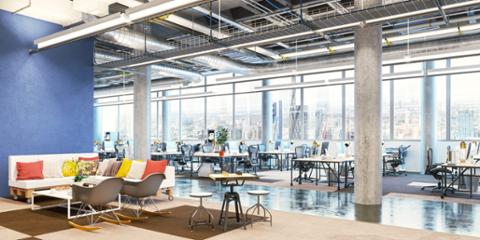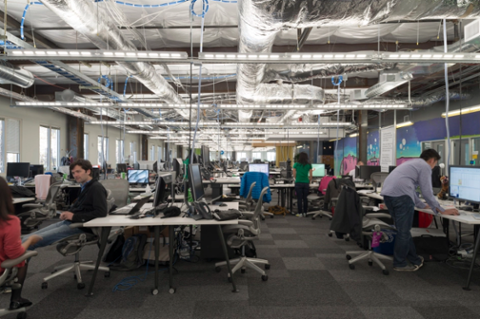Open offices, increasingly favored by tech giants and chic startups alike, have been getting a lot of bad press lately.
Critics complain about the noise and lack of privacy that come with having every employee sitting in an open area; researchers report that such layouts increase sick time and decrease productivity. In the face of such criticism, some employers have begun rethinking their approach. They’re looking at ways to
add more private spaces, and
incorporating options such as stand-up desks to help workers avoid the physical pitfalls of remaining in one position all day long. But such changes take time, and it may be a while before the estimated 70 percent of U.S. workers who sit in an open office each day (according to the International Facilities Management Association) see any meaningful modifications to their environment. Companies have long believed that open offices increase the opportunities for communication and collaboration, said Kylie Roth, director of workplace research and strategy for Knoll, Inc., a designer and manufacturer of workplace furniture: “It’s about the access of people to one another, and a continual transfer of ideas.” The open setup, however, isn’t equally effective for all companies that utilize it. “People still need privacy and a place to focus,” Roth observed. “People can’t be out in the open all the time.”
Here and Now
So how does your average tech pro make the most of an open office? A lot depends on the corporate culture, the people with whom you work, and the way the office is actually designed. Here are some general things to think about:
- Combat Distractions: Noise is one of the most common complaints about open offices, and using headphones to dampen it is one of the most common recommendations. Be aware of other factors that disrupt your concentration; if constant passers-by distract you, for example, ask to move to a more remote spot, or see whether a partial wall can be attached to your workstation to minimize the impact.
- Seek Refuge: A well-designed open office will offer “refuge” spaces where you can get a break from the buzz. Sometimes these are separate rooms where you can close the door; or they might be tables placed in a quiet corner. Whatever the options, build time into your day to take advantage of them.
- Tailor Your Day: Think about your workday: how you like to organize it, and how your energy impacts your mood during different times. For example, some people find it easy to concentrate in the morning but become less focused as the day goes on. If that’s the case, block out some afternoon time to make phone calls, either at your desk or in a separate room. Accept the fact that people will say “good morning” as they arrive and “good night” as they leave; during those times, take on tasks where brief interruptions won’t be so bothersome, such as checking email or catching up on your news feeds.
- Communicate: Don’t suffer in silence. Your colleague at the next desk may not be aware he’s loud on the phone, so be ready to ask nicely if he can use a private room for his conference calls. If someone has a habit of tapping you on the shoulder with a question every 15 minutes, ask if they can send an email whenever they see you have headphones on.
- Watch Others: Be aware of your own habits, how others work, and how you can respect their space—after all, you might be the one with the loud telephone voice.
Get Into the Discussion
If your company is planning to move or reconfigure your existing space into an open office, you have an opportunity to impact the workspace design—so long as you speak up, Roth said. In many cases, organizations will engage an architect and interior designer to develop the office’s layout. As part of that work, they’ll research the company’s dynamics, looking at the type of work being done, how often each individual is actually in the office, how much time people spend in meetings, and the type of culture the company is trying to maintain. While those discussions take place, look for ways to make your opinions known. Some companies hold town halls or survey their employees as part of the process; others put together focus groups or a committee. Whatever your firm’s approach, it’s important for you to explain what you need in order to do your job effectively. If you frequently work with confidential information, for example, an open workstation may not be appropriate for you. If you’re uncomfortable with your back to the room, see if you can get a desk that allows you to face traffic areas. If you need to focus without distractions for long periods of time, lobby for adequate “refuge” spaces where you can hunker down. For all their pitfalls, open offices do offer some positives. They facilitate collaboration and information-sharing, and make it easier to get answers to simple questions or feedback on your work. If you do find yourself out in the open, don’t spend too much energy seeking privacy through refuge spaces or headphones—take advantage of the opportunity to engage.


